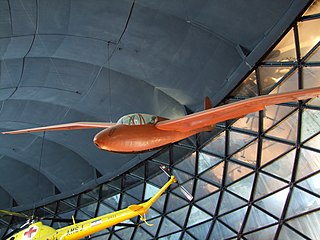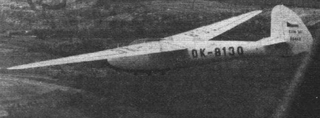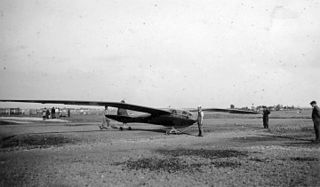
The Schempp-Hirth Discus is a Standard Class glider designed by Schempp-Hirth. It was produced in Germany between 1984 and 1995 but has continued in production in the Czech Republic. It replaced the Standard Cirrus. It was designed by Klaus Holighaus.

The VSO 10 Vosa is a Standard and Club-Class glider designed and manufactured in the Czechoslovak Republic from December 1978 as a replacement for the VT-116 Orlik II.

The SZD-12 Mucha 100 was a single-seat glider aircraft that was designed and built in Poland from 1953.

The SZD-24 Foka (Seal) was a single-seat high performance aerobatic glider designed and built in Poland in 1960.

The Scheibe Bergfalke is a German glider designed by Egon Scheibe as a post-World War II development of the Akaflieg München Mü13 produced before and during the war.
The Akaflieg Braunschweig SB-11 is an experimental, single seat, variable geometry sailplane designed by aeronautical students in Germany. It won the 15 m span class at the World Gliding Championships of 1978 but its advances over the best, more conventional, opposition were not sufficient to lead to widespread imitation.

The Arsenal Air 100 is a French single seat competition sailplane produced in the 1940s. It sold in small numbers but set several records, still holding the world absolute solo glider endurance record of 56 h 15 m.

The Breguet 901 Mouette is a very successful single seat French competition sailplane from the 1950s. It was the winner at both the 1954 and 1956 World Gliding Championships.

The Breguet Br 905 Fauvette is a single-seat, standard class, competition sailplane, designed and produced in France from the late 1950s. Some 50 were built but most remained grounded after a structural accident in 1969; a few remain airworthy.

The Ikarus Košava is a two-seat sailplane designed and built in Yugoslavia in the early 1950s. It won the 1954 World Gliding Championships in the two seat category and came second in the same event two years later.

The Cijan-Obad Orao is a competition single seat sailplane designed in Yugoslavia just after World War II, one of the most advanced of its type at the time. It flew in three World Gliding Championships, having greatest success at its first in 1950 when it reached third place.

The Ikarus Meteor is a long-span, all-metal sailplane designed and built in Yugoslavia in the 1950s. It competed in World Gliding Championships (WGC) between 1956 and 1968 and was placed fourth in 1956; it also set new triangular-course world speed records.
The VTC Delfin is a competition single seat Standard class glider designed and built in Yugoslavia in the 1960s. It had some success in national competitions and went into small scale production.
The Scheibe SF-30 Club-Spatz is a 15 m class single seat sailplane built in Germany in the 1970s and intended for club use.
The VFW-Fokker FK-3 is a single seat competition glider, built in Germany in the late 1960s. It had success at the Italian and Austrian national contests of 1968, resulting in a short production run the following year.
The IFIL-Reghin RG-5 Pescăruș or CIL Reghin RG-5 Pescăruș was a Romanian single seat sailplane built in the 1950s. Twenty six were constructed for gliding clubs.

The Zlín Šohaj series of club gliders began as a post World War II development of the DFS Olympia Meise. A large number were built in the 1940s and '50s.

The PWS-102 Rekin was a progressive development of the PWS-101, intended for cross-country flights. The prototype flew in an international contest in 1939 and the first of a projected production series was flown before the start of World War II.
The PWS-103 was a high performance, Polish 15 m span sailplane developed from the longer-span PWS-102 just before World War II.
The Bréguet Br 902 Cinzano was a French training glider produced in the 1950s by Société anonyme des Ateliers d'aviation Louis Bréguet






















